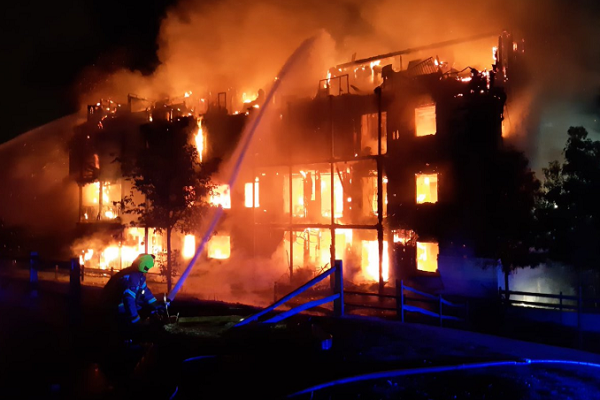Government sought ‘independent experts’ to help rebut critical media reports two days after Grenfell fire
Government officials sought “independent experts” willing to follow a “pre-prepared script’ defending their official guidance from media criticism two days after the Grenfell Tower fire, new emails released today by the inquiry reveal.
An email from 16 June 2017 showed senior official Brian Martin approaching the National House Building Council (NHBC) as part of an effort to rebut a story that ran in The Times which suggested the cladding used on Grenfell Tower was permitted under English building guidance.
He wrote: “I’ve been told to prepare a rebuttal of the assertion that [polyethylene]-cored ACM [aluminium composite material] panels comply with the guidance in [Approved Document B].
“I’ve also been asked if an independent expert would be willing to say this (or something similar) in public? Can you consider the attached and let me know please.”
The request came at a moment when the government was under intense pressure from the fall-out of the fire, with the perceived inadequacy of Approved Document B, the official building guidance on fire safety, attracting substantial criticism.
On the same day the email was sent, former housing minister Gavin Barwell, who had recently been named chief of staff at Theresa May’s No 10, was pursued down Whitehall by reporters demanding answers over his failure to review the document before the fire.
The claim that the guidance in fact banned the highly combustible polyethylene-cored ACM cladding used on Grenfell Tower would go on to be a crucial line of its defence against criticism, but it was always deeply divisive in the industry.
The claim was based on a passage in its official guidance headed “insulation materials”, which said any “filler” was required to meet the tough fire standard of ‘limited combustibility’. It would say this referred to the combustible core of an ACM panel, effectively outlawing the panels on the tower.
But this claim has always been challenged by industry experts who assert that ‘filler’ in fact referred to ‘Polyfilla’-type materials used to fill gaps in insulation.
There was widespread belief that cladding panels were in fact subject to ’Class 0’ or Euroclass B, a lower fire standard which some ACM products claimed to achieve.
In the 16 June email, Mr Martin attached a rebuttal script effectively setting out the government’s position on the interpretation of the word ‘filler’, which he was asking the NHBC to repeat.
The email was sent to Diane Marshall, operations director at the NHBC, who completed her evidence to the inquiry today.
Lead counsel to the inquiry Richard Millett QC asked: “Did you consider it appropriate that a government official was approaching you with a pre-prepared script in support of government after the Grenfell Tower fire?”
“I think it was unusual,” replied Ms Marshall.
“But did you think it was appropriate?” asked Mr Millett
“I don’t know if I considered it at the time,” she replied.
Ms Marshall replied to Mr Martin saying the opinion might appear “more independent” if it came from the Building Control Alliance (BCA), a body which represents all building control inspectors in the UK.
“It would only be the view of one building control body [if it came from the NHBC] and if Brian was looking for support or an independent view it would be more representative of industry [if delivered by the BCA],” she explained.
It has since emerged that Mr Martin had been specifically warned that the word ‘filler’ was not understood in the way he claimed from as early as 2014, and he had ignored advice to publish a frequently asked question that clarified the position.
He had also been warned by an industry figure in 2016 of “grave concerns” about the widespread use of the product in the UK, and advised to publish further guidance making it clear that it was outlawed. He had responded by saying he did not believe the existing guidance was “all that ambiguous”.
Ms Marshall had earlier been asked about guidance the NHBC published in July 2016, which said ACM panels could be used in cladding systems in the UK, providing they had a Class B rating under European standards.
However, she insisted this guidance did not endorse the use of the violently combustible panels used on Grenfell, which have a core made of 100% polyethylene, a plastic which burns as fiercely as petrol in a fire and had been linked to a series of devastating cladding fires worldwide.
She based this claim on a passage in the document titled ‘Restrictions On Use’, which said: “The use of [polyethylene] or [polyethylene] / mineral cored aluminium composite material panels which do not achieve a minimum Class B combustibility fall outside the scope of this guidance note.”
She was repeatedly challenged by Mr Millett to accept that this wording invited the use of the dangerous panels, providing they had a Class B rating.
Ms Marshall insisted that it did not, explaining that the document should have contained a comma after the first reference to ‘polyethylene’.
Referring to Mr Martin’s email asking her to support the view that the product was banned in the UK, Mr Millett asked: “Was the real problem here that you cannot be seen to be disputing the assertion that the polyethylene-cored panel was accepted for use on the current building regulations precisely because your 2016 guidance note said... that you accepted PE-cored ACM panels so long as they achieve Class B?”
“No, I disagree,” said Ms Marshall, insisting that the guidance note excluded the use of polyethylene-cored ACM.
The panels ultimately installed on Grenfell Tower were sold with a certificate that claimed they achieved Class B rating. It has since emerged that manufacturer Arconic had been concealing test data which showed they were the far lower standard of Class E when bent into the shape used on the tower.
Yesterday, the NHBC’s own fire engineer said the guidance document “should not have been written” and did not disagree when asked if it was “dangerous” and sought to achieve “business as usual at the expense of life safety”.
Ms Marshall said she did not agree with this view.
She was also asked about a speech she gave at a conference in 2016, when she explained that NHBC were concerned about the use of combustible materials because of the potential prosecutions and warranty claims that could follow in buildings it had either signed off or insured.
“Can you explain why the safety of residents living in buildings which were potentially unsafe found no mention in your speech, only the impact to NHBC in terms of criminal and civil law?” asked Mr Millett.
“I think that was taken as a given,” Ms Marshall said. “We were looking at compliance... with standards and compliance with regulations that ensure buildings are safe.”
The inquiry continues.
Sign up for our weekly Grenfell Inquiry newsletter
Each week we send out a newsletter rounding up the key news from the Grenfell Inquiry, along with the headlines from the week
Already have an account? Click here to manage your newsletters












